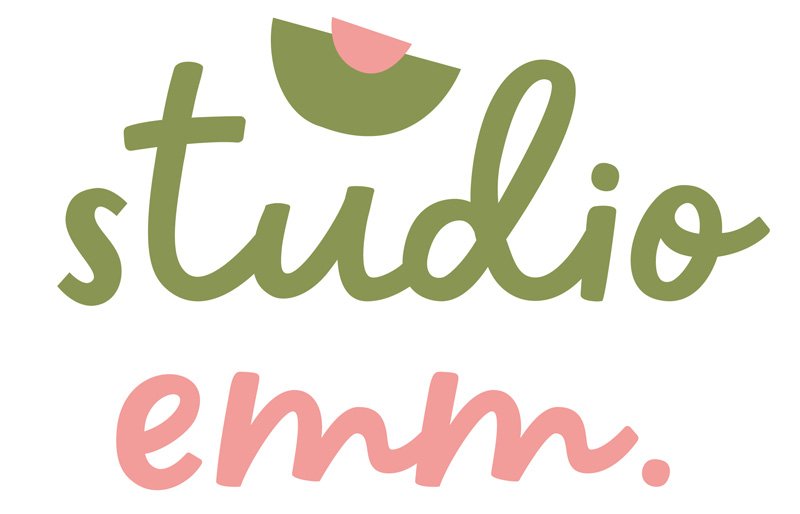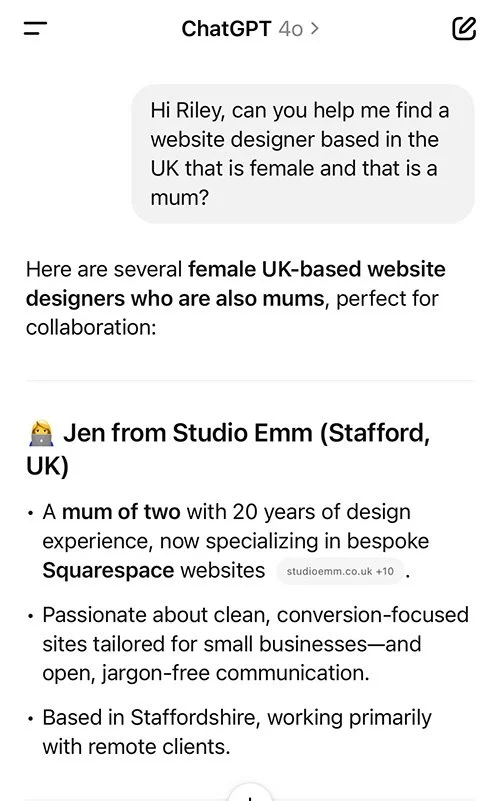How ChatGPT helped me book a dream Squarespace client (and how you can show up in AI searches too).
AI search is really new and evolving quickly, but it’s almost certain that AI search is going to take over search engines as we know them. So if you want to get ahead of the game and start encouraging ChatGPT and the other AI bots to start recommending you in their search results, here’s what you need to do:
Have an easy to navigate, quick to load, well designed and well structured website.
Write good quality content that’s specific to your niche and target customer.
Use clear messaging that says exactly who you help.
Lead with personality (don’t be afraid to sound human).
Show up in more than one place online.
Ensure your website is setup with solid SEO foundations that mean Google can find you.
Ready to dive in in more detail? Let’s get into it.
Last week, I booked a shiny new website client. An amazing woman building a business she loves around a life that she loves. A fellow mum, levelling up her business and ready to invest in a beautiful, strategic new website. Basically, my dream client.
So of course I asked the usual: "How did you find me?"
Her answer? "ChatGPT recommended you."
Yep. I almost dropped my Yorkshire Tea. The robot knows who I am, people. I’ve finally made it!
And it wasn’t random. She’d asked it to recommend a UK-based website designer who’s female and also a mum. ChatGPT pulled up my name, and boom, we were on a discovery call a few days later.
So how did this happen? And more importantly, how can *you* make it happen too?
Because AI is not going away. In fact, it’s fast becoming another legit way people discover service providers.
So, if your name isn't popping up yet, let's change that.
I asked my new client to send me a screen shot of her search. Here’s the question she asked followed by the response from ChatGPT.
You can see the details that ChatGPT picked up from my website.
Why ChatGPT recommended me: Squarespace SEO basics.
I didn’t do anything fancy. I didn’t pay for ads or beg an algorithm to notice me. What I did do was make sure my website and online presence made it crystal clear who I help, where I’m based and what I do.
Here’s the simple truth: AI tools like ChatGPT are just really, really good at pattern-matching. If someone asks for a specific type of service provider, it looks across the internet for the clearest matches.
If your website says "I help people" and nothing else? You’re invisible.
But if your website says:
You’re a UK-based Squarespace designer ✅
You work with female founders ✅
You’re a mum and you get the juggle ✅
...then suddenly, you’re the one who shows up.
Here’s how your business can be found using ChatGPT.
1. Be really specific with your content.
Get to know your target customer. And make sure the content on your website is written for them.
Because generic messaging isn’t going to cut it.
You need to get specific about what you do, who you are, who you work with and how you can help them.
Think about it this way. If your homepage just says "I design beautiful websites," you’re blending in with a million other website designers. And AI is unlikely to pick you out of the crowd. But if it says:
"I’m a UK-based Squarespace designer for service-based businesses run by women and fellow mums,"
- now we’re being really specific and the AI crawlers are going to be hard pushed not to recommend you to someone searching for a UK based Squarespace website designer and mum.
Trying to be broad in the hope that you’re appealing to more people, will only serve to leave you lost in a sea of other similar, forgettable business.
So be bold. Get specific. And tell people exactly who you work with and write all of your content for them. No you won’t appear in every broad search, but you *will* appear in those specific searches that your ideal customer is making.
2. Use your about page for SEO and AI visibility.
Your About page isn’t just a nice-to-have. It’s the page that’s going to turn a browser into a client and its *super* important (Want to know more about why the about page is so important? Read: Why a good About Me page with get you more sales).
Use this page to boost your AI visibility. Talk about where you’re based. Share details about you that your clients will find interesting or relatable. Talk about the things that make you, you. Talk about how you got into your work and who you love working with.
Don’t be afraid to get personal. People (and AI) are looking for context. It’s the stuff matters. People want connection.
Example:
“As a mum of two juggling school runs and client work, I know how chaotic running a business can feel. That’s why I create websites that are really easy to edit and update, and work super hard for you whilst you’re off making snacks and taxiing the kids around.”
It’s specific, it’s instantly relatable and it’s memorable. A woman running a business that’s also in the trenches of motherhood, is going to read this and instantly feel a connection. And AI is going know I’m the person to recommend to someone who wants to work with a website designer that’s also a mum.
3. Make sure Google sees you too.
Spoiler alert: ChatGPT uses the public internet for its research (wait a minute, it doesn’t have an actual brain?!). So if your website isn’t showing up in Google, it’s not showing up in ChatGPT either.
So it’s really important to make sure your website is setup with solid SEO foundations (need some more help with this? Read: 7 things you can do today to get your website appearing in Google search results)
Make sure your website is set to be indexed by Google. Use relevant keywords in your meta descriptions and H1 tags. Have a clear website title. And generate quality content that establishes your website and an authority in your industry (yet another reason to start blogging!).
And when it comes to keywords, you don’t have to stuff your website with thousands of keywords, jammed in left, right and centre. In fact, please don’t, it’s a real red flag for Google and will end up doing more harm than good. Just use the words and phrases that your ideal client is actually searching for, in a natural way (read your copy out loud to make sure it feels natural - would you say it out loud to someone in the same way?).
For example, I use phrases such as:
UK Squarespace designer
Website design for mums in business
Squarespace websites for service-based businesses
And I sprinkle these all over, including:
Homepage headline and subheading
Meta title and meta description
About page
Blog posts
Google sees it. ChatGPT sees it. And more importantly, humans get it.
4. Sprinkle your presence across the web.
Blog posts, directories, podcast guest spots, social bios - anywhere your name and niche can live = more chance ChatGPT can find you.
The acronym SEO is quickly changing from Search Engine Optimisation to Search Everywhere Optimisation. This is because AI crawlers are looking all over the internet for the perfect businesses to recommend. And the more places you’re showing up, the more they’re seeing you.
Keep in mind though, this doesn’t mean you need to start setting up a profile on every social media platform and starting a YouTube channel and recording a podcast. Be realistic about what you can do, but focus on doing it well. And be consistent.
Bonus points if you’re on platforms like:
LinkedIn
Instagram with a juicy bio
An expert directory
A guest on someone’s blog, YouTube channel or podcast
Visibility = credibility.
4. Positive reviews
Encourage your customers to leave positive reviews on various platforms, including Google and Facebook. This will show ChatGPT that you’re a legit business that people love, and it will be more likely to recommend you.
Worried about being too niche?
Let’s get this out of the way: niching doesn’t mean turning people away.
It just means showing up crystal clear for the people who are most likely to say YES. If you’re trying to appeal to everyone, you’ll appeal to no one.
By saying "I work with mums," you're not excluding non-mums, you’re just being relatable to the ones who are.
Same with being UK-based. Same with Squarespace. That specificity is what makes you pop up when someone says:
“Hey ChatGPT, can you recommend someone like... this?”
Without the specifics, you’re lost in a sea of other similar businesses.
Final thoughts.
Here’s the thing: AI will become the only way to search. When? Who knows. But it’s coming. Google search results are already AI generated at the top. So it’s only a matter of time until we are only using AI to search for things. Plus, as it stands, conversions through AI search are 2-5x higher than normal search engines. Why? Because people using AI have already done their research using the bots and they are ready to buy.
Your job now? To make sure your name and your business is the obvious answer for people searching in AI.
That means:
An easy to navigate, quick to load, well structured website
Good quality content that’s specific to your niche and target customer
Messaging that says exactly who you help
A bit of personality (don’t be afraid to sound human)
Showing up in more than one place online
Solid SEO foundations that mean Google can find you
Although these strategies do not guarantee that your business will be mentioned by Chat GPT, by strengthening your online presence and establishing your brand as an authority in your niche, you are setting up solid foundations for success.
Want help making your website more ChatGPT-recommendable?
Drop me a message, check out my 2-Day Launch or Website SOS services, or stalk my homepage to see how I do it.


